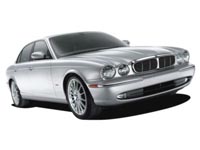Jaguar XJ epitomizes some highlights of British motoring
 Coventry, England - The Jaguar XJ, which celebrates its 40th birthday this year, in a sense epitomizes the very best and worst of British motoring.
Coventry, England - The Jaguar XJ, which celebrates its 40th birthday this year, in a sense epitomizes the very best and worst of British motoring.
Driving an XJ is an emotional experience that clearly differs from the cool precision of taking the wheel in a Mercedes.
For a start, there is the distinct smell of the opulent leather interior coupled with neatly arranged dials on the wooden dashboard, giving it an aura of luxurious opulence.
Nevertheless, the Jaguar engineers were masters in the art of giving a large sedan both a sporty and elegant appearance. Its front grille - coupled with four round headlights and a wildcat on the bonnet - is instantly recognizable the world over.
The first XJ was unveiled at the Paris Motor Show in 1968. Jaguar soon began naming its cars based upon the evolution of the engine. Jaguar used a simple designation method. Initially a new engine was described as "experimental" or simply "X". In the course of the development stage the engineers started with "XA", finally reaching the "XJ" in the final stage.
Until then, there was no luxury sedan with the performance of a sports car. Even by today's standards, output of 109 kilowatts (kW)/149 horsepower (hp) or 136 kW/186 hp remains impressive. With a top speed of 190 kilometres per hour, the Jaguar XJ had little to fear from its rivals. But that did not stop Jaguar from working on an even more powerful motor.
The new engine made its debut in the 1971 Jaguar E-Type and then in the 1972 XJ model, catapulting it into a class of its own. It was the first time that a 12-cylinder engine was fitted to a four-door sedan since the end of World War II. The 186 kW/253 hp power unit clearly put it into the sports car category. These first generation XJ12s not only had a phenomenal performance, but fuel consumption was out of this world by today's standards, since Jaguar opted for a total of four carbuerators instead of a fuel injection system.
Total production of the Series 1 reached some 60,000 units. Small wonder then that Jaguar wished to continue the success story by launching the Series II in 1973. Apart from the four-door, the line- up also included the sleek XJ Coupe, which was launched in 1975 and produced for only two years.
The original construction of the XJ went into a third round in 1979 and was designed by Pininfarina, arguably for many the finest cars in the XJ generation. The redesigned interior especially gave it a high-class look. It was only in November 1992 that the last of the XJs left the assembly line, after production of some 400,000 units. (dpa)